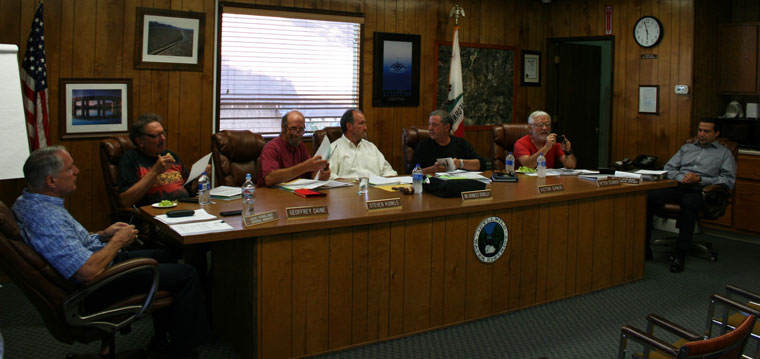
The full board of directors of the Idyllwild Water District voted to adopt multiple regulations involving rules and regulations, water and sewer standby fees, water and sewer rates, fees and charges and the budget for 2017-18 last week. The votes were unanimous in all but one, adoption of Resolution 738, water and sewer rates, fees and charges. Director Geoffrey Caine abstained in that vote.
Public hearings on resolutions for standby fees, and water and sewer rates, fees and charges were held prior to the board vote. Interim General Manager Jack Hoagland said both hearings were properly noticed — standby fees with a notice in the Town Crier 30 days prior to the hearing, and rates, fees and charges with a 45-day notice mailed to district customers. Both will become effective July 1, according to Hoagland. He noted that adoption by resolution as opposed to ordinance does not require a 30-day period within which to receive public comment.
Prior to discussing agenda items and in response to public comment, Hoagland noted that the board would be reviewing district investment policy beginning in July; explained why Director Steve Kunkle recused himself in budget vote noting that Kunkle, as a retiree of the district, is entitled to medical benefits for the rest of his life and that votes on the budget would personally impact him; and why the district is no longer determining the appropriate size of water meter for any property.
During the agenda portion of the meeting, Hoagland addressed Ordinance 64, which permits the GM to move the district to a “No Stage” status. Hoagland explained to the board his reasons for moving to “No Stage” as current water-source sufficiency —“Foster Lake is full; Foster Lake wells are above 50 feet; downtown wells are above 15 feet; average rainfall/precipitation exceeds 26 inches; and storage tanks recharge to 95-percent capacity.” “No Stage” goes into effect July 1.
Salient features of adopted new rules and regulations (Resolution 740) include: water facilities connection fee (new service/additional facilities) is recalculated and apportioned to the various potential water-meter sizes; customers requiring a larger meter will get credit for size of existing meter against the water facilities connection fee for the larger meter; will-serve letters expire 18 months after issuance; and customers may request any meter up to 1 inch. Anything larger than 1 inch will require county permitting support.
Section 3 of the resolution states that the directors find “Rules and Regulations for Water Service were determined to be exempt from California Environmental Quality Act (CEQA), qualify as Class 7 and 8 categorical exemptions, and have been determined to be exempt pursuant to CEQA Guidelines 15307 and 15308.”
Adoption of resolutions 736 and 737 for water and sewer standby fees for undeveloped parcels within the district was pro forma inasmuch as fees were not proposed to change for the new fiscal year and will be collected on the unified property tax bill issued by the county.
Hoagland’s memo to the board in proposing adoption of new water rates, fees and charges (Resolution 738) contends proposed changes comply with state Constitutional requirements, the American Water Works Association principals of developing water rates and industry norms in Southern California. The wastewater rate structure will not change for 2017-18.
Changes for commercial and industrials users include eliminating “pre-paid water” and lowering “base rate” for all commercial meter sizes. Residential users, under the new structure, receive the same 300 units per month of “pre-paid water” with higher tier pricing designed to “reflect the District desire to discourage extensive exterior landscape irrigation and the higher cost of providing those additional supplies.”
When subsequently questioned by press whether the newly adopted structures comply with current California law, under Proposition 218 and as reflected in an appellate court decision “Capistrano Taxpayers Association Inc. v. City of San Juan Capistrano,” Hoagland stated, “The district has the information to support [basing tier structure] on cost of supply and movement of water. We, as a district, are now required to ‘show our work’ [‘fees proportional to the cost of service attributable to each customer’s parcel’ as required under Proposition 218] and in Capistrano, the court found [the district] did not. We did prepare a cost of service study and based our rates accordingly.”
Hoagland explained that tier one rates are based on fixed costs, tier two on power/delivery costs that go up and down based on consumption, and tier three on additional costs of using in-town, “more inefficient wells that are pumping against the pressure head of the system” and, consequently, cost more to deliver the water.
Under the appellate court decision, public agencies such as IWD bear the burden of demonstrating compliance with Prop 218 and current case law, as defined in Capistrano. Any district customer has standing to contest whether or not the district is, in fact, complying.
Interested readers can review both Prop 218 (http://vigarchive.sos.ca.gov/1996/general/pamphlet/218text.htm) and the Capistrano decision (http://caselaw.findlaw.com/ca-court-of-appeal/1698183.html) to inform themselves about water tier pricing and compliance with current law. The California Supreme Court has refused to decertify the appellate court decision.
Finally, the board voted to approve the fiscal year 2017-18 budget. Hoagland observed in notes to the board that: water base rate and water sales may increase with the selling of new water meters in the coming year; county property taxes to the district are expected to remain the same as the previous year; district operating and general expenses are expected to increase 1 percent; and capital improvements will cost $747,000 with $577,000 financed by the district and $170,000 with a grant from Riverside County.
Capital expenditures are forecast for well rehabilitation and well drilling ($175,000); storage tank repairs ($50,000); water line pipe replacement ($310,000); water treatment plant pH monitors ($7,000); fire hydrant improvements ($15,000); and other equipment ($20,000). The budget for sewer-department capital improvements is $170,000 with $135,000 allocated to clean and video the complete collection system for the improvement district and the balance for treatment plant and other equipment.
In GM comments at the conclusion of the meeting, Hoagland mentioned progress in finding a certified wastewater treatment operator; that the district will need a sewer pump replacement in the near future, with a new type of pump, probably a $40,000 expenditure; that the district is working to improve its transparency in the conduct of its business and, as part of that transparency, having a recording of board meetings online may be available within a three-month timeline; and that, in general, the staff and board are working to conduct business with “a lot less drama” than previously. “We have good, hardworking employees,” said Hoagland. “On the water side, we’re in good shape. On the sewer side, we need staff.”
Board packets for the June 21 meeting are available at the district office. The next regular meeting of the IWD board is at 6 p.m. Wednesday, July 19, at the IWD boardroom.









